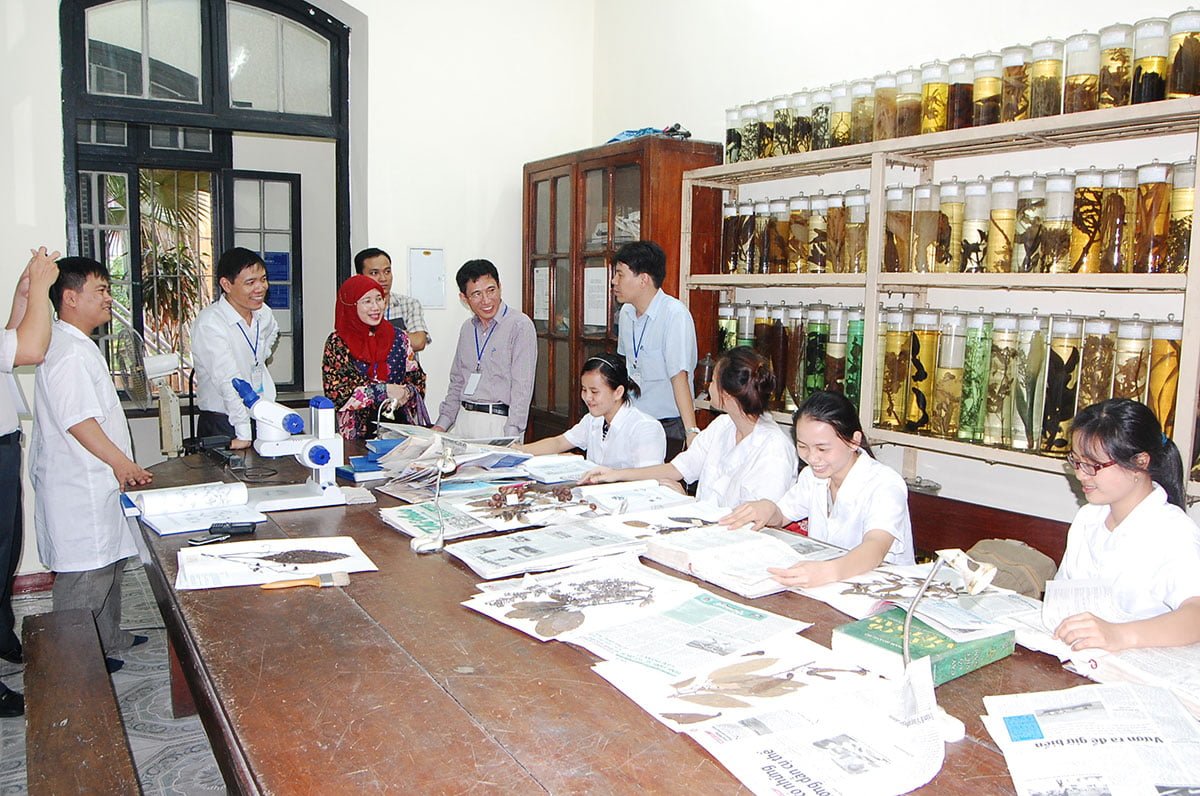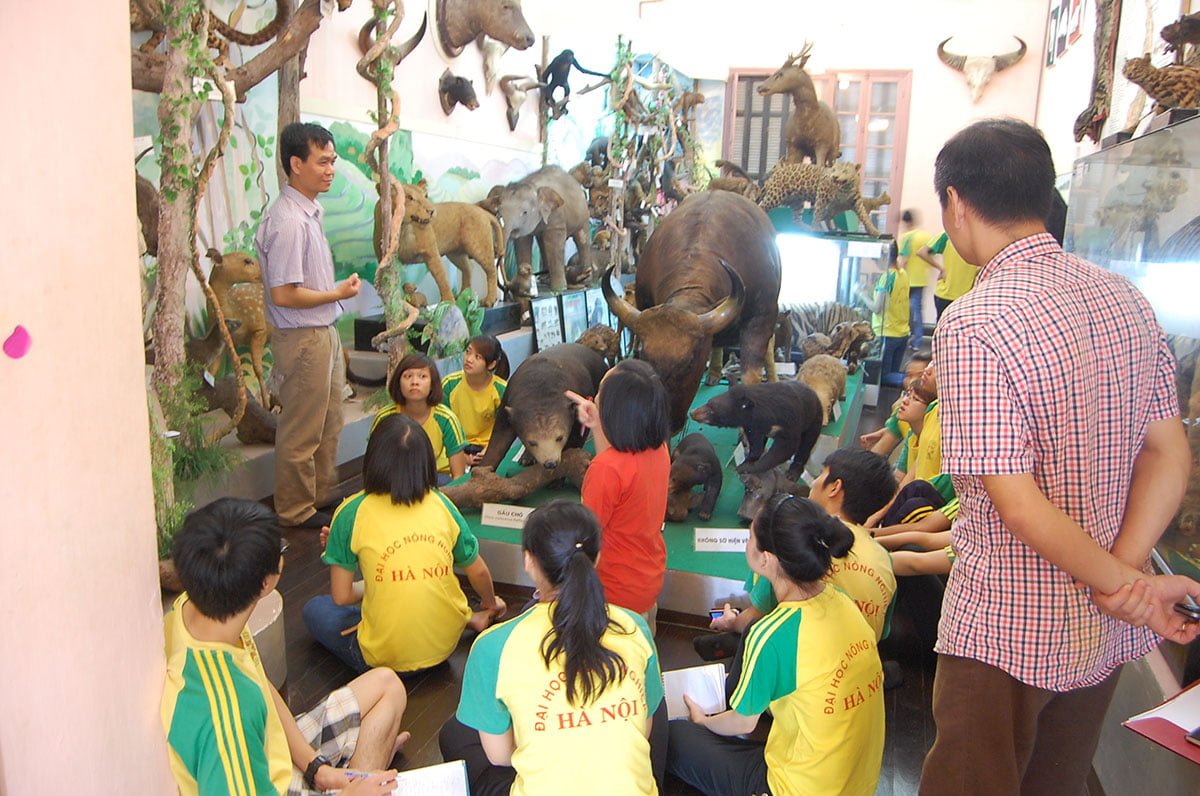Biological Museum, which is a division of the Faculty of Biology since 1956, was established early in 1926. This is the first biological museum found in Vietnam and in Indochina. Nowadays, the museum has been preserving thousands of animal and plant specimens collected from different regions of Vietnam. In addition, numerous specimens which are gifted from state leaders, foreign scientists and/or museums of different nations, are collected from different geographic regions of the world. Therefore, the collections of the Biological Museum have become a valuable treasure of Vietnam because it is containing a brief but thorough overview of the country’s biological resources and biodiversity.
Specific divisions: Herbarium division, Invertebrate division, Vertebrate division.
Facilities: 01 Multimedia room, 07 Exhibition rooms, 06 Collection rooms.
Management Board and contact
Director: Assoc. Prof. Dr. Nguyen Thanh Nam
Deputy Director: Dr. Nguyen Thi Kim Thanh
Address: No. 19 Le Thanh Tong Str., Hoan Kiem Dist., Hanoi, Vietnam
Tel: (84) 243 933 0586/ 243 8584734; Fax: (84) 243 8582069
Email: baotangsinhhoc@hus.edu.vn
1. STATUS OF SPECIMEN COLLECTIONS
– Herbarium collections: The herbarium collections, which were collected across Vietnam, at the Biological Museum include 28,372 specimens with 22,991 specimens of which are identified belonging to 4,287 species, 1,300 genera and 235 families, while 5,381 specimens have not been determined. Most specimens are in good condition.

– Invertebrate collections: Most of 21,133 specimens are common insect orders such as Coleoptera, Lepidoptera, Blattoptera, etc, and other orders of freshwater and marine invertebrates such as mollusk, echinoderms, corals (Anthozoa). Of which, 19,895 specimens are used in scientific research and 865 exhibition specimens (accounting for 7.9 percent of total specimens). Most of these specimens have not been completely identified and more than 50 percent of specimens are low quality, many specimens lack historical profile.

– Vertebrate collections
+ Collections of fishes: In total there are 6,207 specimens of freshwater, brackish and marine fishes. Among them, there are 1,207 specimens of 396 species that have been identified (accounting for 15.33 percent of total species in Vietnam), including 941 research and exhibition specimens of 350 species and 266 specimens of holotype and paratype of 45 new species discovered in Vietnam that published by Mai Đinh Yen such as Silurus cucphuongensis, Hemibagrus centralus, Altigena tetrabarbat, etc and one paratype of Linecheek tank goby (Glossogobius sparsipapillus Akihito and Meguro, 1976) discovered by former Japanese Prince of Akihito (presently known as the Emperor of Japan) and gifted to the museum in 1976. Therefore, there have been still about 5000 specimens of fishes not yet identified.

+ Collections of amphibian: The total number of amphibian specimens is about 3,770, including 770 identified specimens of 54 species, 17 genera, 9 families, accounting for 30.5% (54/177) of total amphibian species in Vietnam and 3,000 specimens not yet identified. Some paratype specimens of newly discovered species found recently such as Quyet’s treefrog Philautus quyeti, Orlov’s treefrog Rhacophorus orlovi, etc are being preserved at the Biological Museum.
+ Collections of reptile: There are 1,714 specimens of reptile in total. 714 specimens of which are identified as 159 species of 50 genera, 20 families, accounting for 36.6% (159/435) of total reptile species found in Vietnam. Therefore, there have been still about 1,000 specimens of reptile not yet identified.
It is remarkable that the holotype of Tam Dao mountain stream snake Opisthotropis tamdaoensis and many paratypes of newly discovered species such as Hidden bow-fengered gecko Cyrtodactylus cryptus, Roesler’s bent-toed gecko Cyrtodactylus roesleri, Chinese Leopard gecko Goniurosaurus luii are being preserved at the Biological Museum.

+ Collections of bird: There are 3,107 specimens of bird, including 437 exhibition specimens and 2,670 collective specimens, with a total of 381 species of 18 orders, 68 families, accounting for 45 % (381/848) of total bird species in Vietnam.
+ Collections of mammal: There are 2,683 specimens of mammal in total, including 183 exhibition specimens and 2,500 collective specimens in 136 species and subspecies of 70 genera, 26 families, 10 orders, accounting for 45.3 % (136/300) of total mammal species in Vietnam.

Specifically, remains of skin and skull of holotype of Northern buff-cheeked gibbon Nomascus annamensis, which was discovered as a new primate 2010 and specimens of Gray-shanked douc langur (Pygathrix cinerea), which is also a new primate species discovered in 1997. In addition, some specimens of big mammals are unique to the Biological Museum such as Gaur (Bos frontalis), Banteng (Bos javanicus). However, there aren’t specimens of some orders such as Dermoptera, Cetacea, Perissodactyla, Sirenia.
2. USING OF THE BIOLOGICAL MUSEUM’S COLLECTION IN RESEARCH AND TRAINING
Scientific research: The reputation of the Biological Museum is the quantity and scientific quality of historical specimens, especially specimens of holotype and paratype. Thousands of plant and animal specimens are used to study taxonomy, biological resources, biodiversity, and conservation biology, which is one of the most important functions of any biological museum. Until now, thousands of students of undergraduate and graduate, as well as hundreds of scientists from scientific institutes and universities of Vietnam and foreign countries, have come to carry out researches of taxonomy, biodiversity, and biological resources in the Biological Museum. Many scientific papers published recently in domestic and international journals based on the collection of the Biological Museum. Training and Education: Biological Museum always has been keeping the role of the best “natural laboratory” for learning and transfer expertise of biological resources, biodiversity, and conservation biology for undergraduates and graduates to follow the fields of taxonomy, biodiversity, and conservation. Hundreds of theses for Bachelor, Master, and Doctoral degrees on taxonomy, biological resources, biodiversity, and conservation carried out and completed in the Biological Museum. Many national and international workshops and training courses of biodiversity and conservation based on the collection of Biological Museum for theoretical and practical lectures. Annually, there are about 1,000 people who come from different universities, colleges, schools, institutes and museums of Vietnam and foreign countries to the Biological Museum for learning and researching or study tours.
Training and Education: Biological Museum always has been keeping the role of the best “natural laboratory” for learning and transfer expertise of biological resources, biodiversity, and conservation biology for undergraduates and graduates to follow the fields of taxonomy, biodiversity, and conservation. Hundreds of theses for Bachelor, Master, and Doctoral degrees on taxonomy, biological resources, biodiversity, and conservation carried out and completed in the Biological Museum. Many national and international workshops and training courses of biodiversity and conservation based on the collection of Biological Museum for theoretical and practical lectures. Annually, there are about 1,000 people who come from different universities, colleges, schools, institutes and museums of Vietnam and foreign countries to the Biological Museum for learning and researching or study tours.
 Awareness enhancement: For a long time, the Biological Museum has become a common place in Hanoi and Vietnam for raising awareness of biodiversity conservation and environmental protection, inspiring love for nature for pupils and communities. Since 2011, after being received a grant from the Embassy of Japan with total funding of 67,000 USD in 2010 to improve the quality of the exhibition rooms and to standardize exhibition specimens as well as to establish a multimedia room for activities such as professional training, public awareness-raising, and education of wildlife conservation, the Biological Museum has been opened for public audiences, especially targeting to pupils from primary and secondary schools, students from universities in Hanoi and other provinces.
Awareness enhancement: For a long time, the Biological Museum has become a common place in Hanoi and Vietnam for raising awareness of biodiversity conservation and environmental protection, inspiring love for nature for pupils and communities. Since 2011, after being received a grant from the Embassy of Japan with total funding of 67,000 USD in 2010 to improve the quality of the exhibition rooms and to standardize exhibition specimens as well as to establish a multimedia room for activities such as professional training, public awareness-raising, and education of wildlife conservation, the Biological Museum has been opened for public audiences, especially targeting to pupils from primary and secondary schools, students from universities in Hanoi and other provinces.

International cooperation and exchange: Biological Museum is an attractive and convincible place for international collaboration in biological study and conservation following the principles of sustainable development. Projects related to rare species conservation such as projects of protection and conservation of Indochina tiger (Panthera tigris cobetti), northern buff-cheeked gibbon (Nomascus annamensis) and red-shanked douc langur (Pygathrix namaeus),… started from the position of Biological Museum. The Biological Museum have has the relationship and specimen exchange with international museums and related institutions such as the Zoological Museum of Moscow Lomonoxov University; the Zoological Museum of Saint Petersburg University; the Nature History Museum of Paris; the Zoological Museum of Pyongyang’s Kim Il Sung University; Shanghai Fisheries Institute; and Beijing Fisheries Department, etc. Especially, on 17th August of this year, the Royal delegation of Japan’s Prince Akishino visited the Biological Museum and spent almost two hours for exchanging specialized contents on fish, bird and mammals collections of the museum with some Vietnamese zoologists who are working in Biological Museum.

